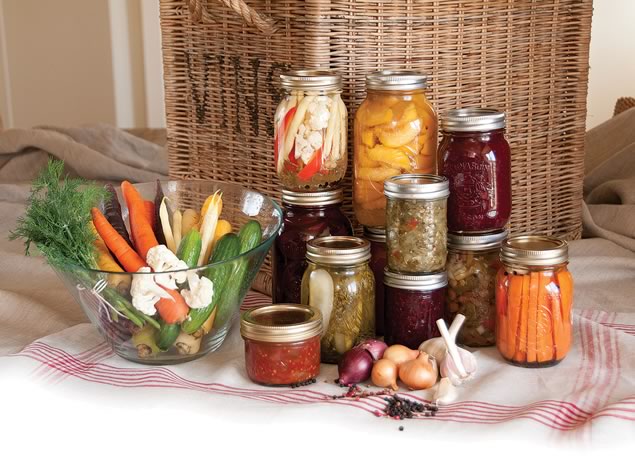Not-Too-Sweet Raspberry Jam
Canning Instructions Follow Cathy’s step-by-step canning instructions in the Dilly Pickle recipe.
Canning Instructions
Follow Cathy’s step-by-step canning instructions in the Dilly Pickle recipe.
Not-Too-Sweet Raspberry Jam
Serves
Makes 5 half-pint (250 ml) jars.
Ingredients
- 4 cups whole raspberries, fresh or frozen
- 2 cups applesauce
- 2 tsp bottled lemon juice
- 3 cups sugar
- 1 pkg Certo Light pectin powder
- ¼ tsp cooking oil (optional)
Instructions
- Combine raspberries, applesauce and lemon juice in a heavy-bottomed pot. (The pot should be at least twice as deep as the contents to allow for a good rolling boil.)
- Bring to a boil and stir until raspberries are broken into pieces.
- Use a spoon to mash stubborn ones.
- If you wish, press mixture through a mesh colander with the back of a spoon to remove some of the seeds.
- Add sugar all at once; continue to boil until it is completely dissolved, stirring constantly.
- Add pectin powder and boil gently for another 5 minutes.
- Skim off any foam that forms on the surface, or add ¼ tsp cooking oil to disperse the foam.
- Using a metal spoon, do a gel test* to determine if the jam has reached the gel point. If not, continue to cook the jam at a low boil until the gel point is reached. Stir to prevent scorching.
- Ladle hot jam into clean, hot canning jars.
- Leave ½ inch of headspace between jam and rim of the jar.
- Close jars, finger-tight.
- Close all jars finger-tight and process in boiling-water-bath canner for 10 minutes for pints and 15 minutes for quarts.
- Remove immediately and let stand until lids “pop” down.
- After 24 hours, check seals by pressing on the tops of jars.
- If any lids spring back when pressed down, they are not properly sealed.
- Refrigerate any unsealed jars and use within 3 weeks.
- Label your preserves, including date, and store in a cool place out of direct sunlight.
- At this point, jar rings can be removed and reused.
Notes
*Gel Test for Jam: Chill 2 or 3 small plates in freezer. Remove jam from heat while doing the test. Place 1 tsp hot jam or jelly on plate and freeze for 1 minute. Remove from freezer. Surface should wrinkle when edge is pushed with finger. If not, continue cooking your jam or jelly, and repeat test every few minutes.
Canning Tips
- Canning is an all-season activity. Plan to can local organic produce in season, but save easily stored produce for the fall and winter.
- Vinegar must be at least 5 per cent acetic acid for food safety.
- Wear rubber-lined dishwashing gloves to protect your hands from steam and provide a better grip than oven mitts.
- A teaspoon of vinegar in the canner will prevent a hard-water film on the jars.
- When preparing jars and lids, prepare a few extra in case your yield is greater than you expect.
- Processing time is always measured from the time the water returns to the boil.
- When pickling whole cucumbers, take a thin slice off the blossom end to help keep the pickles crisp.
- To peel large amounts of garlic, separate the cloves and blanch them in boiling water for 60 seconds, then refresh in cold water. Drain immediately and peel. This also works for small onions.
- The sugar in jams and jellies is required for a good “set.” Sugar in pickles, chutneys and salsa is to taste. Sugar in canned fruit is to maintain a firm texture.
- Rhubarb, berries, cherries and currants can easily be frozen and made into jams and spreads when you have more time.
- Slightly underripe fruit contains the most pectin.
- Experiment with different types of vinegar or add spices (peppercorns, hot chilies, bay leaves, mustard seeds) to create your own special pickles.
- Safe food handling training available online at www.ingoodhands.ca
- Find many useful tips and reliable information online at National Centre for Home Food Preservation
Related Stories

The Practical Art of Preserving
May 18, 2012 | | Back IssuesLearn to make canning part of your food strategy and keep the whole thing manageable, by year-round canning.
Related Recipes

Dilly Pickles
May 16, 2012 | | FoodWhen pickling whole cucumbers, take a thin slice off the blossom end to help keep the pickles crisp.






